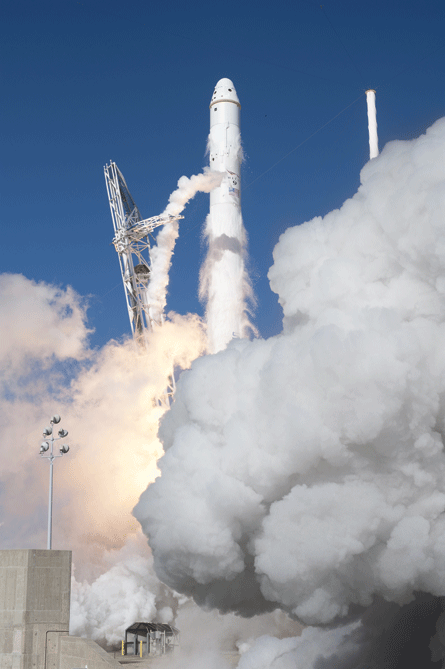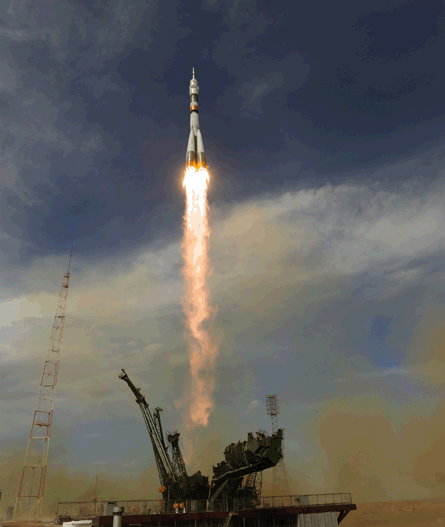After a year of policy U-turns and a funding rollercoaster, 2011 should come as a relief to NASA, after passing at least part of the spaceflight burden to commercial firms.
But that means the pressure is on commercial spaceflight companies such as SpaceX and Orbital Flight Sciences, which are not only expected to stage successful launches, but also, ultimately, to turn a profit.
SpaceX ended 2010 well when its Dragon capsule became the first successful commercial space vehicle, lifting off aboard the California-based company's Falcon 9 two-stage-to-orbit rocket on a mission co-sponsored by NASA. The 8 December mission was NASA's first launch of a commercial vehicle and the start of its demonstration programme to develop new ones, and was the Federal Aviation Administration's first issue of a licence to a commercial company to re-enter a spacecraft from orbit.
 |
|---|
© SpaceXSpaceX ended 2010 on fire with Dragon |
TEST FLIGHTS
Two more test flights are scheduled for 2011. Chief executive Elon Musk says SpaceX will be ready for the next mission by mid-year, expanding the flight envelope and possibly going directly to the International Space Station if NASA gives the green light.
Orbital Flight Sciences is also planning a big year, with the test flight of its Taurus II rocket and Cygnus spacecraft. This is its challenger to Dragon/Falcon 9 in NASA's Commercial Orbital Transportation Services (COTS) programme, which is aimed at spurring growth in the commercial space industry and enabling the birth of a private space cargo industry.
The US space agency also goes into the new year with a better-defined national space policy - although the White House will need to pull it into clearer focus for it to be viable. US President Barack Obama went into 2010 with the intention of killing the George Bush-era ambitious-but-expensive Constellation programme, which was intended to include the development of spacecraft and booster vehicles to replace the Shuttle, return US astronauts to the Moon and eventually beyond.
Obama's fiscal year 2011 budget proposal did not include funding for the programme and, in March 2010, NASA began shutting it down in accordance with the president's directive, despite having already poured about $9 billion into developing the Constellation's Ares rockets and Orion crew capsule.
But on 15 April, Obama directed NASA administrator Charles Bolden to immediately take the already-developed Orion technology and begin developing a rescue vehicle.
As the Obama administration's space policy has evolved, it has brought hope for more than just Constellation and its components. The new policy emphasises international co-operation, although in some ways, the USA's hand will be forced internationally. As the Space Shuttle programme closes down, NASA will become dependent on Russia's Soyuz to reach the ISS for crew swaps and cargo deliveries.
The Russians will begin preparing for a change to their own access to space in 2011. The country's Federal Space Agency plans to start constructing the Vostochny cosmodrome in eastern Russian in 2011. The new launch site, set to be operational by 2018, will replace the Baikonur cosmodrome in Kazakhstan, from which ISS missions are launched. The preliminary design contract for the seven-pad site was awarded to TsSKB-Progress, the state-controlled production centre that also builds Soyuz rockets. An $800 million three-year spending package was announced by prime minister Vladimir Putin in July 2010, but that is only a fraction of the estimated $13.5 billion final cost. And if the perennial delays of Soyuz launches from Centre Spatial Guyanais, the French-owned spaceport near Kourou, French Guiana, are any indication, getting launches up and running by 2018 will be no small feat for Roscosmos.
Although equipment has been shipping from Russia to Kourou since mid-2008, even in early 2010 it was clear that problems with the completion of the launch complex would delay the first Soyuz mission.
SOYUZ AGREEMENT
Nevertheless, Roscosmos and Arianespace continued negotiating the purchase of 10 additional Soyuz-ST rockets, reaching an agreement in June. As 2010 rolled to a close, Arianespace announced completion of delivery methods for liquid oxygen, liquid nitrogen, and hydrogen peroxide to the Soyuz pad and in November said the completed mobile service tower had been moved to the launch pad.
 |
|---|
© ESA |
Mid-2011 may also see the end of the Space Shuttle programme. The last two approved spaceflights were to have been carried out by Discovery on 1 November and Endeavour in February 2011, but November delays for Discovery saw that flight pushed to February.
But the 2010 rollercoaster ride could continue into 2011. More uncertainty for NASA and the Shuttle programme comes with the tentative approval from Congress and the White House for an additional flight, which would be carried out by Atlantis.
Source: Flight International


























